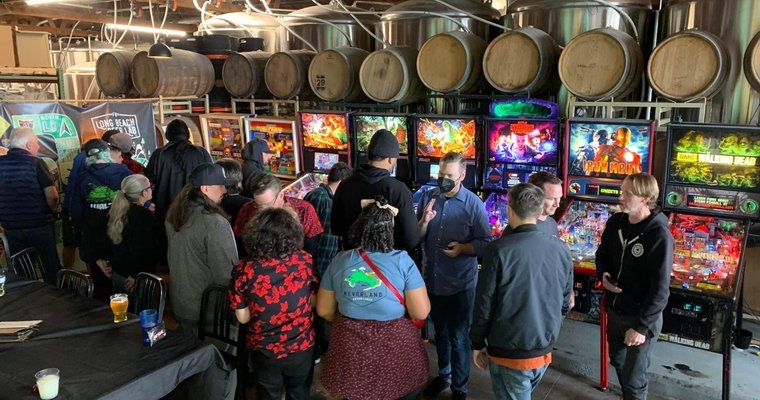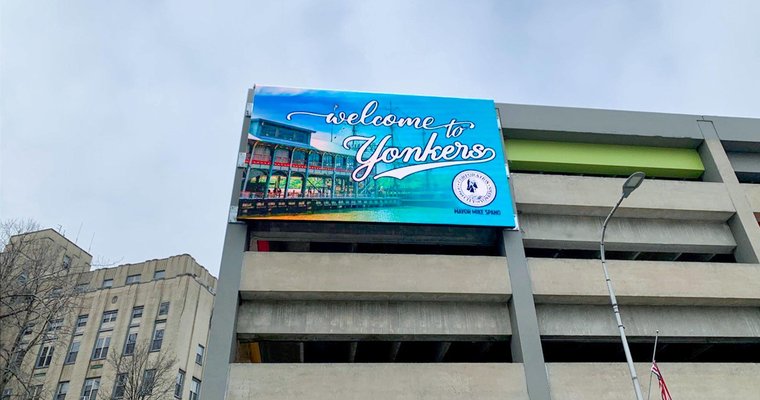
[ad_1]
Far sighted food and beverage establishments are cashing in on improved game machine technology, the popularity of social entertainment and the emergence of digital out of home marketing.
 Patrons at a brewery stay busy at the pinball machines. Photo by Stern Pinball Inc.
Patrons at a brewery stay busy at the pinball machines. Photo by Stern Pinball Inc.
For most Americans, an evening out with friends and/or family usually consists of food and entertainment. Traditionally, these two events happened in sequence, but nowadays, they often come together.
Chains like Dave & Buster’s, Round1 Bowling & Amusement, Punch Bowl Social and Topgolf have fine-tuned the combination. But many traditional restaurants and bars are also getting their fair share of the double whammy.
Traditional dining and drinking establishments in tune with their guests are cashing in on improved game machine technology, the popularity of social entertainment and the emergence of digital out-of-home marketing.
A new beginning
When Michael Bajec and his partners launched The Lucky Duck bar and food truck in Austin, Texas in 2020, there was no question the venue would include game machines.
Since he began managing bars in 2011, Bajec developed a relationship with Bar Partners Inc., a local amusement machine operator, and he hasn’t looked back.
The business now includes a 10,000-square-foot location in San Antonio that features four basketball hoop machines, a fast pitch machine, two skeeball machines, one crane machine, one photobooth machine, one punching bag machine and a string cutting game machine.
“For us, the real importance of it is extending people’s visit time when they’re in our place,” Bajec told this website in a phone interview. “It’s more about people enjoying themselves, creating a memory.”
Bajec does not think the revenue from the games surpasses that of the food and beverage sales on a per space basis, but the games keep people on premises.
“It’s kind of a chicken and egg thing,” he said. “If you take all these games out and you stuff it with people buying drinks in that same space, I would get more revenue from those people buying drinks, but on the other hand, the games help bring people in and keep them here. If I don’t have the games, less people come in.
“It’s a combination of the tried and true classics, the hoops and skeeballs and then new kind of fun things, the string cutter and the duck claw machine — things people haven’t seen before,” he said.
The machines are also placed in some parts of the bar that aren’t used as much as other spaces. The crane machine, for example, is in a corner area that would never have a table for customers.
A ‘win/win’ for Denny’s
 |
Garren Grieve |
“As we see it, it’s sort of a win/win for the business and guests alike,” said Garren Grieve, president and CEO of Seaside Dining Group, an Aliso Viejo, California based operator of 28 Denny’s stores in California. “It’s a form of entertainment for our guests, and obviously the natural benefit is it provides a nice source of revenue for our business to be able to keep up with the increasing cost pressures that we have within the business.
“They serve as two functions,” he said for the games serviced by National Entertainment Network. “We’ll have times when you have families waiting for a table for 10 or 20 minutes. These machines act as a source of entertainment for our guests. Demographically, it’s sort of all over the board, especially age wise. We have adults playing a game.”
The right assortment
As with any business, having the right merchandise is critical. Bajec recognizes that the machine needs to fit the location. Here is where he relies on his amusement specialist.
Bajec credits Bar Partners with coming up with the idea of the rubber duck crane machine. Players win rubber ducks.
“It was their idea to put the Lucky Duck crane machine in, and that thing people love,” he said. “I had some doubts, but they knew what they were talking about. They know what’s popular. They see the numbers.”
Bajec and his partners do not review the machine activity in real time, he said, since they don’t feel the need based on the trust in Bar Partners.
The Lucky Duck receives a single set share of the revenue for all the machines under its agreement with Bar Partners.
 |
Randy Chilton |
Restaurant game rooms grow
“Restaurants have been a strong trend for many years,” Randy Chilton, chief marketing officer, National Entertainment Network, a national provider of game machines and vending machines to retailers and restaurants, said in a phone interview with this website. “But the growing trend in restaurants (for the last five years) is certainly in the game room sector of which many restaurant owners are calling us to make their game area bigger: full game rooms, carded systems. Some of the restaurants like it so much they buy their own equipment.
“The category has been performing better today than it has in 10 years,” he said for the restaurants. “It’s a new day. It’s a growing category with all the technology and the branding that we’re doing.”
 |
Games such as the Axe Master from Baytek have created more engaging guest experiences. Photo provided by Smithland Enterprises/One Source Amusement. |
Technology on the move
Machine technology has made a difference. “They’re all digitally activated; people are signing up for loyalty programs on the machine,” Chilton said.
James Smith, a partner at Euless, Texas based Smithland Enterprises/One Source Amusement, a nationwide route operator managing more than 2,500 jukeboxes and amusement machines in more than 400 locations, agreed that technology has catapulted the industry.
More than a decade ago, jukeboxes introduced a mobile app for mobile payments, which now account for 80% of jukebox sales, the balance being cash. The company uses AMI Network Entertainment Inc. jukeboxes.
“It’s fantastic,” Smith said for the mobile app. “That’s a lot of money we don’t have to count.”
More recently, card payment systems have stimulated amusement machines.
Partnering with Kansas City-based Amusement Connect on card payment systems, about half the company’s amusement machine sales are made with payment cards that the customer gets by inserting a credit or debit card into a kiosk that dispenses a payment card.
“You just tap each game any time you want to play,” Smith said. “When the card runs out of money you reload. The kiosk is part of the card system.”
Brand marketing
Digital out-of-home technology has also enhanced the customer experience, Chilton of NEN said. DOOH has supported consumer brand marketing on machines, including videos on the machine headers that promote toy brands and other brands.
“It’s the new digital-out-of home experience where you put your monitors and attach them to the physical asset and then you can manage them all remotely under a new revenue stream,” Chilton said.
 |
Evan Kirby |
Evan Kirby, director of North American commercial sales at Sterm Pinball Inc., agreed.
“The most successful games of ours out in restaurants/breweries are often those with recognizable and popular licenses,” Kirby said. “Jurassic Park, Star Wars and Marvel are just a few examples of popular licenses that Stern is partnered with.”
 |
Games with recognizable branding have proven popular, especially with enhanced graphics. Photo provided by Smithland Enerprises/One Source Amusement. |
Restaurants’ considerations
The biggest challenge for traditional restaurants is having sufficient space for games, Chilton said.
“If you put in a machine or two, you’re probably taking out a booth… but our highest per square foot return is in restaurants, period. It’s shocking,” he said. “One or two games have a really high return on investment.”
Doug Koch, a now-retired veteran Denny’s franchisee, remembers when crane machines began replacing cigarette machines in restaurants in the early 1990s. Koch affirmed Bajec’s point that the machines need to fit the venue.
As a Denny’s franchisee, Koch tested a variety of games in addition to the crane machines, such as Pac Man in the early 1980s, but the crane machines always performed best for family oriented Denny’s. The Oregon market was exceptional in that the Denny’s restaurants did well with game rooms for multiple slot machine games.
Kirby at Stern Pinball agreed that food and beverage establishments need to think strategically about the games they install.
“Locations with one or two machines tend to do less than those with four or more,” Kirby said. “The reason being that in certain settings, it can almost be intimidating for players to be the first to step up and play a loud machine. Having more machines in a location makes them seem more inviting and will result in increased plays with increased comfort playing them.”
Management support
Kirby also pointed out that the level of an establishment’s management support is also important for maximizing game benefits.
“When management is more engaged with pinball, such as getting involved with tournaments and leagues and even managing the placement of the machines, they bring in more earnings,” Kirby said. “But the earnings don’t stop with just the coinbox. One of the great benefits of pinball is the utility it provides the location. Pinball players tend to enjoy the social and community aspect of the game, which means more time spent at the location, food and drink being consumed and more pinball being played!”
 |
Food and beverage venues need to allot sufficient space to maximize game benefits, which include building guest loyalty. Photo provided by Stern Pinball. |
Lester Hahn, co-owner of River City Amusements, a West Bend, Wisconsin-based amusement machine operator, thinks many restaurants and bars shortchange themselves by not listening to the operators they work with. This is especially important as technology has evolved.
“There is a huge difference in machines,” he said. “Now there’s a plethora of games that can go into a spot.”
“If you don’t set the atmosphere up correctly the machines cannot make the money that you could be making, so there are multiple dynamics to making money,” he said.
The slot and poker machines are usually the most profitable, he said. But you have to have the right features. He compared it to a taxi having the proper aesthetic qualities versus a drab one.
Restaurants and bars that fail to respond to the consumer demand for competitive socializing will lose sales to family entertainment centers, which are on a rapid growth curve.
Family entertainment centers are expected to grow at a combined annual growth rate of 12.29% through 2026, according to Technavio, a market researcher. The report pegged the current market value at $21.05 billion.
Part two in this two-part series will focus on the expansion of “bar arcades” and competitive socializing.
Photos provided by Stern Pinball, Smithland Enterprises/One Source Amusements and LinkedIn.
Elliot Maras is the editor of Kiosk Marketplace and Vending Times. He brings three decades covering unattended retail and commercial foodservice.
[ad_2]
Source link






